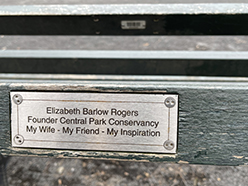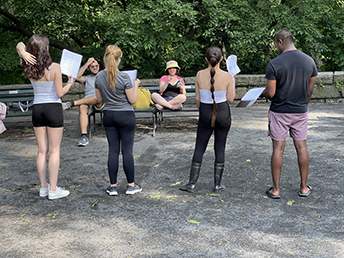July 14th, 2023
Summit Rock, the Tallest Point in Central Park as a Palimpsest of Multi-generational History
According to the dictionary, the word “palimpsest” means something reused or altered but still bearing visible traces of its earlier form.”
 I live opposite Summit Rock and enter the park at 81st Street and Central Park West and, and for me this this front-door familiarity often encourages me to walk over to this natural landmark and climb the steps cut into its southern flank by the park’s mid-nineteenth-century builders. When I reach the top I am standing on a particularly interesting page of the Central Park palimpsest. Sitting on the bench with a donor plaque inscribed with my husband Ted’s loving encomium. I can look down across the forested eastern slope at the foot of which is the tiny pool of water where Tanner’s Spring seeps from the ground, once a source of pure drinking water for Seneca Villagers and now a birdwatchers sighting point for the random species that fly in for a sip or to splash-clean their feathers in the spring’s basin of water, which appears as wet-mud mirror rimmed with a few casually fallen tree limbs and a scatter of dead leaves.
I live opposite Summit Rock and enter the park at 81st Street and Central Park West and, and for me this this front-door familiarity often encourages me to walk over to this natural landmark and climb the steps cut into its southern flank by the park’s mid-nineteenth-century builders. When I reach the top I am standing on a particularly interesting page of the Central Park palimpsest. Sitting on the bench with a donor plaque inscribed with my husband Ted’s loving encomium. I can look down across the forested eastern slope at the foot of which is the tiny pool of water where Tanner’s Spring seeps from the ground, once a source of pure drinking water for Seneca Villagers and now a birdwatchers sighting point for the random species that fly in for a sip or to splash-clean their feathers in the spring’s basin of water, which appears as wet-mud mirror rimmed with a few casually fallen tree limbs and a scatter of dead leaves.
 Turning my head, I can look over my shoulder at the latest palimpsestic layer of the top of Summit Rock as a designed landscape, one in which the Central Park Conservancy fortunately scratched out a fenced-in rectangular sandbox that was a standard feature in children’s play areas built by Commissioner Robert Moses in the vicinity of twenty-two of the park’s entrances in the 1930s. Today this page of the Central Park palimpsest has my own handwriting on it because of the fact that the Central Park Conservancy’s landscape restoration team that I had appointed and supervised during the time I was its founding president is responsible for its current design: a simple lawn crowning the crest of Summit Rock with a bluestone-paved terrace and its supporting wall serving as its eastern border. The terrace, which faces a curving row of back-to-back benches including the one I am now sitting on, sometimes serves as a casual outdoor stage for an amateur Shakespeare group’s sporadic performances, and the lawn, which retains some archaeological references in the form of exposed bedrock surfaces that may have served as foundations for the some of Seneca Village’s vanished built environment is a popular place to picnic and stretch out on the grass for a nap.
Turning my head, I can look over my shoulder at the latest palimpsestic layer of the top of Summit Rock as a designed landscape, one in which the Central Park Conservancy fortunately scratched out a fenced-in rectangular sandbox that was a standard feature in children’s play areas built by Commissioner Robert Moses in the vicinity of twenty-two of the park’s entrances in the 1930s. Today this page of the Central Park palimpsest has my own handwriting on it because of the fact that the Central Park Conservancy’s landscape restoration team that I had appointed and supervised during the time I was its founding president is responsible for its current design: a simple lawn crowning the crest of Summit Rock with a bluestone-paved terrace and its supporting wall serving as its eastern border. The terrace, which faces a curving row of back-to-back benches including the one I am now sitting on, sometimes serves as a casual outdoor stage for an amateur Shakespeare group’s sporadic performances, and the lawn, which retains some archaeological references in the form of exposed bedrock surfaces that may have served as foundations for the some of Seneca Village’s vanished built environment is a popular place to picnic and stretch out on the grass for a nap.
The sale to the city and subsequent removal of Seneca Village in 1857 in order to create Central Park does not have to be considered from woke perspective as it sometimes is, and it is important to keep in mind that it was a racially mixed community and its predominant population consisted of fully enfranchised, relatively prosperous free Black citizens of New York City. For this reason, therefore, the footprint of this successful nineteenth-century African-American New York City Upper West Side neighborhood that existed for more than forty years inspired the Central Park Conservancy to choose this site for an event honoring of the traditional Black holiday called Juneteenth, a commemoration of the order by Major General Gordon Granger proclaiming freedom for enslaved people in Texas on June 19, 1865. Thus, for a day the grounds of the now-vanished nineteenth-century settlement of Seneca Village encompassing, and including, the top of Summit Rock became the logical place to celebrate Black freedom with an event that was both entertaining and didactic.
I was happy this year to enter Central Park at 81st Street on June 19 and immediately see the familiar landscape representing the area that was once occupied by Seneca Village as the site of “a family-friendly celebration of Black wellness through dance, music, art-making, comedy, self-care, and more” according to the flyer that was being handed out.
Immersing myself in an entire experience of what was going on, I was soon sitting on the grassy meadow at the base of Summit Rock and engaged in Mindfulness & Breathwork with Harlem Yoga Studio’s Ellie Cassaba. I then noticed that the celebration of freedom was indeed ringing in the air, which included African Dance performed by the Asase Yaa Cultural Arts Foundation and Historical Spirituals sung by the choir from Mother Zion Church, one of Seneca Village’s three historic churches and the only one that still exists in present-day Harlem. Mother Zion’s musicians further contributed to the spirit of the day in collaboration with jazz virtuoso Melvin “Khemestry” Fowler, composer and band leader whose métier is called Afrofuturism. As a premiere of sorts, some of his new pieces were being performed by his group, Renaissance Jazz, along with traditional spirituals and Duke Ellington’s “Freedom.”
An artistic impression of freedom was offered by the Sugar Hill Children’s Museum at a table laid out with bundles of colorful synthetic hair that two women were braiding into patterned plaits like those that African-Americans had once used as road maps signaling to one another the best routes to take on their flight to freedom. At another table the Studio Museum in Harlem was offering instruction in how to make cyanotype prints using sunlight to create images of selected natural objects such as fallen leaves and fronds of ferns that had been gathered in nearby parts of the park.
In addition, to these expressions of historical Black artistry, the Juneteenth Central Park celebration offered participatory individual physical and spiritual guidance. An African Dance ensemble sponsored The Asasa Yaa Cultural Arts Foundation was on hand “to ground us in our bodies and the history around us” and healing exercises were offered by Somatic coach Jen Chau Fontán, a teacher at the Harlem Yoga Studio. Another physically and spiritually beneficial exercise option was offered by the Harlem Wellness Center at an improvised Racial Healing Labyrinth, which was intended to to foster “quiet reflection and listening from within as a means of discovering a stronger and more compassionate connection across racial lines.”
_
Here I have only singled out one sample of the Central Park metaphorical palimpsest. The entire park can be considered as one of course, a document inscribed and reinscribed throughout its 166 years of existence to date. That it so firmly grounded geologically, ardently protected as a living landmark, and graciously hospitable to events such as Juneteenth is a marvel. That the marks on the palimpsest are not as they used to be scars from wounds of misuse is a cause for appreciation. That the park as an entirely public landscape is supple enough in its design to accommodate celebratory events like Juneteenth while every day visitors, who are both park neighbors and visitors from elsewhere, write their own stories of love and appreciation on a fresh page of the Central Park palimpsest. In this way the document acts as a receptacle for intergenerational happy memories as well as a prod to discover our better selves as members of a unified society.
Share
